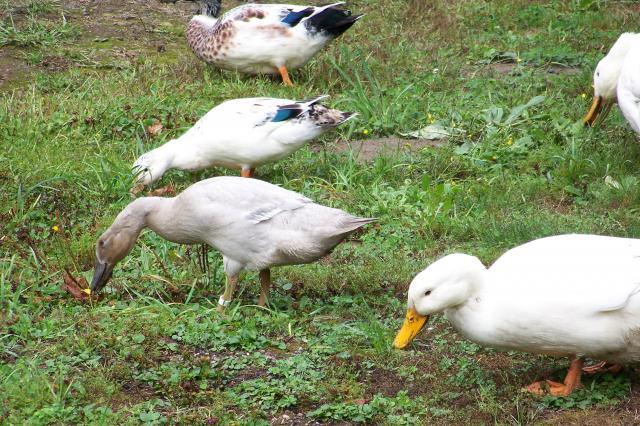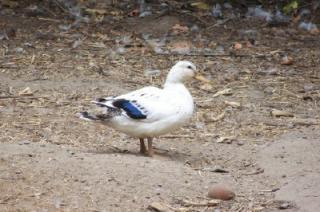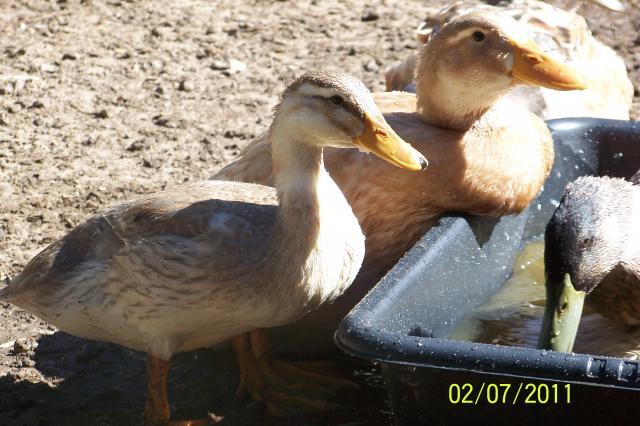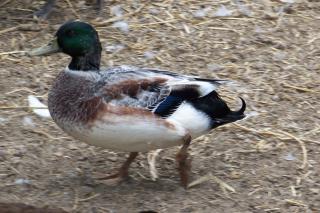- Mar 21, 2009
- 2,229
- 52
- 349
Quote:
I'm sure they have similar hybrid layers in Australia, but I doubt that it is the same breeding that Rollyard has going on (He actually already knows the parents are Saxony and Dark Dusky). The Metzer Golden 300's are a mix of more than 2 breeds, based on the well known sex-linked combination of breeding a Brown drake (of any breed) to a Black duck (also of any breed). Several of us have conjectured before about what all might have been included in the Golden 300's. Having watched their sexing video, I suspect they used just about every breed they raise, rather than just 2 or even 3 breeds (and possibly even some they don't typically raise).
There is too much variation in color for that not to be the case- all of course are the required Brown for the F1 hens and Black for the F1 drakes (reverse of the parent generation) but, some are Bibbed, some aren't, some are wild-type, some aren't, some are extended Black, some aren't, some are Harlequin phase, some aren't, one he holds up in the video even appears to be Restricted Mallard. To get all of those variations, they had to have used many different breeds. They are basically an awesome laying mixed breed of extremely varied history that rely highly on the phenomenon of Hybrid vigor. They are a really cool duck. I am going to order probably 20 of them (10 of each sex) just to see what all I get as far as mix of colors. You are very right as well that Rollyard might have some sex-linked gene involved even though those two parent breeds normally do not carry any sex-linkage. I think that is a great observation on your part. It shouldn't be the case with Saxony to Dark Dusky, but it may very well be part of what is going on.
I'm sure they have similar hybrid layers in Australia, but I doubt that it is the same breeding that Rollyard has going on (He actually already knows the parents are Saxony and Dark Dusky). The Metzer Golden 300's are a mix of more than 2 breeds, based on the well known sex-linked combination of breeding a Brown drake (of any breed) to a Black duck (also of any breed). Several of us have conjectured before about what all might have been included in the Golden 300's. Having watched their sexing video, I suspect they used just about every breed they raise, rather than just 2 or even 3 breeds (and possibly even some they don't typically raise).
There is too much variation in color for that not to be the case- all of course are the required Brown for the F1 hens and Black for the F1 drakes (reverse of the parent generation) but, some are Bibbed, some aren't, some are wild-type, some aren't, some are extended Black, some aren't, some are Harlequin phase, some aren't, one he holds up in the video even appears to be Restricted Mallard. To get all of those variations, they had to have used many different breeds. They are basically an awesome laying mixed breed of extremely varied history that rely highly on the phenomenon of Hybrid vigor. They are a really cool duck. I am going to order probably 20 of them (10 of each sex) just to see what all I get as far as mix of colors. You are very right as well that Rollyard might have some sex-linked gene involved even though those two parent breeds normally do not carry any sex-linkage. I think that is a great observation on your part. It shouldn't be the case with Saxony to Dark Dusky, but it may very well be part of what is going on.












